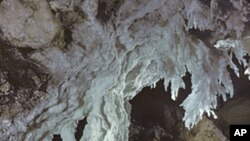New research findings suggest the key to finding a whole new variety of antibiotics to treat drug-resistant infections may lie with the resident bacteria in one of the most isolated caves in the world.
The U.S. scientists who conducted the study say bacteria collected from Lechuguilla Cave in the state of New Mexico appear to possess an innate resistance to antibiotics, despite never having been exposed to any human sources.
Some of the bacteria had a pre-existing defense against as many as 14 different antibiotics. In all, the scientists say the cave-dwelling organisms showed a naturally-developed resistance to virtually every antibiotic currently used to treat bacterial infections.
While this may sound like bad news, the researchers explain that finding isolated, drug-resistant bacteria actually is a good thing. They say it suggests there are many types of previously unknown, naturally-occurring antibiotics in the environment that can be developed for doctors to use against currently untreatable infections.
First discovered 70 years ago, antibiotics are only effective against disease caused by bacterial infection. However, decades of widespread overuse, especially in agriculture industries, and via over-prescription by doctors, has made increasing types of disease-causing bacteria - so-called superbugs - immune to antibiotics.
There is increasing concern among scientists and medical experts that current antibiotic treatments could become completely ineffective against bacterial infections, which would be catastrophic for millions of people around the world suffering from diseases such as malaria.
Meanwhile, the scientists who conducted the new research point out that none of the Lechuguilla Cave bacteria used in their work are capable of making people sick.
The study was led by researchers from McMaster University and the University of Akron, both in the state of Ohio. A report on their findings is published in the journal, PLoS One (Public Library of Science One).
Bacteria are highly-adaptable microscopic single-cell organisms. One of Earth's earliest life forms, evidence in the fossil record indicates bacteria have existed for about 3.5 billion years.
In addition to malaria, examples of other serious illnesses caused by bacterial infection include bubonic plague, tuberculosis, salmonella, and certain types of pneumonia and meningitis.
However, not all bacteria are bad or cause disease. Most are harmless to humans. Naturally-occurring bacteria in the human body help digest food, provide vital nutrients, fight cancer cells, and destroy disease-causing microbes.
Lechuguilla Cave was discovered in 1986. Since then, the U.S. Park Service has tightly restricted access to only a few scientific researchers and cave experts per year. Surrounded by a thick layer of watertight rock, the cave also is geologically isolated. The scientists say it can take up to 10,000 years for water to reach the inner-recesses of the cave where they collected the bacteria samples for their study.
Some information for this report was provided by AP, AFP and Reuters.







